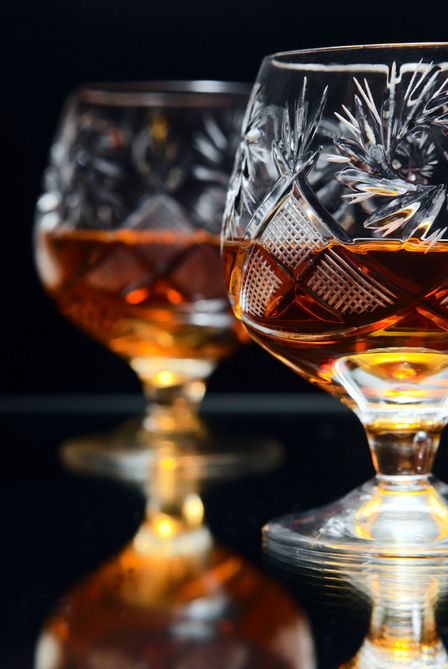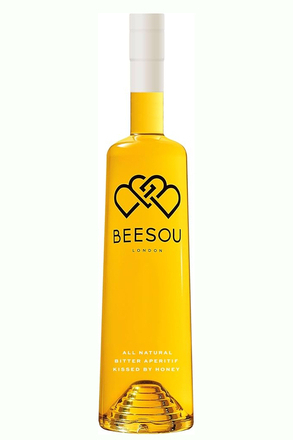Words by Simon Difford

Liqueurs and alcoholic cordials are sweetened alcoholic drinks made by mixing or redistilling spirits with flavourings and colourings. Within the EEC a ‘liqueur’ must have an alcohol content of at least 15% alc./vol. and a minimum sugar content of 100g per litre - this legislation harks back to the days when sugar was an expensive luxury.
In Europe, particularly the UK, people tend to think that a cordial is a non-alcoholic mixer (like Rose's lime cordial). But the words liqueur and cordial actually mean the same thing. Cordial comes from the Latin 'cor' for heart, reflecting the medieval custom of serving liqueurs as medicines to stimulate the heart.
The French word liqueur also has Latin roots; it is derived from the word 'liquefacere' meaning to melt or dissolve. The Italian word for liqueur is 'liquori', which also encompasses dry spirits and fortified wines.
Liqueurs and cordials can be made with everything from holly berries to vipers, including herbs, flowers, roots, spices, fruit and fruit stones. Unfortunately, for many the word 'liqueur' connotes a sweet and sticky (or creamy), low-alcohol, unchallenging drink. True, many liqueurs fit this description - and many of these are very tasty - but there are also many more 'serious' liqueurs out there for the discerning drinker.
Origins
Recipes for making digestive liqueurs have been discovered in Egyptian tombs and classical Greek scrolls. But it is monks who are credited with the development of liqueurs during the Middle Ages. They were the medical men of their time and hence were interested in plants, herbs and the medicinal and preserving properties of alcohol. Their work to formulate the alchemical 'elixirs of life' resulted in the creation of delicious herb based drinks. Some of today's best-known liqueurs (such as Chartreuse) originated in monasteries and were initially produced and marketed for their medicinal qualities.
By the 15th century the Italians were the leading liqueur makers. Every noble home had a small still and the women of the household would create their own special recipes. These liqueurs were used as primitive anaesthetics during childbirth and bought as aphrodisiacs by lovers - they were also drunk against a wide variety of ailments. The newly available herbs and spices from the New World and the East, including chocolate, oranges and ginger, influenced the variety of liqueurs made. When Catherine de Medici married Henry II of France, she took the fashion of drinking liqueurs to the French court, which affected French drinking habits into the next century.
In Victorian England liqueurs came into vogue - they were drunk from small glasses by ladies at the end of the meal. One of the popular liqueurs of the period was Ratafia; the name probably derives from the Creole word for molasses spirit, Tafia. Many liqueurs went under this title, most coloured and flavoured with red fruits. Liqueurs dropped in popularity at the turn of the 20th century, but the boom in cocktail bartending has begun to bring liqueurs back in from the cold.
How are liqueurs produced?
Liqueurs are generally made by adding flavourings to a base spirit or spirits and then sweetening with sugar, although most producers keep their secret recipes heavily guarded. The following methods can be used to extract flavours from fruit and other botanicals and many liqueurs employ several of these methods to make their component parts.
Steeping & maceration
Fruit and botanicals are steeped in cold alcohol for days, weeks, months, or sometimes as long as a year. The term maceration is particularly used when the botanical being steeped is chopped or shredded to expose more surface area so allowing more efficient flavour extraction by the alcohol.
Infusion
Fruit and botanicals are steeped in warm alcohol (usually 40 - 50ºC, but occasionally up to 60ºC). This process is sometimes known as 'digestion'. Liqueur flavourings made by steeping, maceration or infusion are known as 'tinctures'.
Percolation
This is an intensive, more efficient method of maceration. Pure alcohol is forced through the botanicals to extract the flavour as quickly as possible. The alcohol may be cold, hot or even a vapour, and the process may be continuously repeated in a closed cycle.
Distillation
Botanicals are distilled with neutral alcohol, producing a clear distillate with some of the flavour of the botanicals. The richly perfumed distillate produced is a mixture of alcohol and essential oils and is known as an 'esprit'.
Maturation
Some liqueurs are then aged in oak or just left to marry before being reduced to the required bottling strength and bottled.
Liqueur Terms
Crème de ....
Many fruit liqueurs are described as 'crème' followed by the name of a fruit. This term refers to the liqueur's quality as in the phrase 'crème de la crème' and does not mean the liqueur is based on dairy products. In the EEC liqueurs named 'crème' must contain a minimum sugar content of 200g per litre, with the exception of blackcurrant (crème de cassis) which must contain 400g per litre.
Demi-Fines
A French term for a liqueur with a strength of around 23% alc.vol. and a sugar content of 200g - 250g sugar per litre.
Double Liqueurs
A French term for liqueurs that have literally double the concentration of 'surfines' and are designed to be diluted. Double crème de cassis is the most common example of double liqueurs.
Esprits
A term given to spirits distilled with botanicals that are used to flavour liqueurs. These are made by placing herbs or spices into a still containing neutral alcohol. This mixture is left to marry for a period before it is distilled. The richly perfumed distillate produced is a mixture of alcohol and essential oils.
Fines
A French term for a liqueur with a strength of around 28% alc./vol. and a sugar content of 400g - 450g per litre.
Surfines
A French term for the strongest and sweetest liqueurs, usually at least 30% alc./vol. with 450g - 500g sugar per litre.
Tinctures
Flavourings used in the production of liqueurs. These are made by maceration or infusion.

Belle de Brillet pear liqueur
Category: Liqueurs / alc. cordials
Sub category: Fruit liqueurs
alc./vol: 30

Italicus Rosolio di Bergamotto
Category: Liqueurs / alc. cordials
Sub category: Fruit liqueurs
alc./vol: 20

Luxardo Aperitivo
Category: Liqueurs / alc. cordials
Sub category: Bitter liqueurs (Amari, Fernet, Quinquina, Kina & China)
alc./vol: 11

Difford's Falernum
Category: Liqueurs / alc. cordials
Sub category: Botanical (herb/spice)
alc./vol: 18

Pallini Limoncello
Category: Liqueurs / alc. cordials
Sub category: Fruit liqueurs
alc./vol: 26

Cointreau liqueur
Category: Liqueurs / alc. cordials
Sub category: Fruit liqueurs
alc./vol: 40

Hayman's Sloe Gin
Category: Liqueurs / alc. cordials
Sub category: Fruit liqueurs
alc./vol: 26

Montenegro Amaro
Category: Liqueurs / alc. cordials
Sub category: Bitter liqueurs (Amari, Fernet, Quinquina, Kina & China)
alc./vol: 23

Adriatico Amaretto Liqueur
Category: Liqueurs / alc. cordials
Sub category: Nut liqueurs
alc./vol: 28

Strucchi Bitter
Category: Liqueurs / alc. cordials
Sub category: Bitter liqueurs (Amari, Fernet, Quinquina, Kina & China)
alc./vol:

St. Elizabeth Allspice Dram
Category: Liqueurs / alc. cordials
Sub category: Fruit liqueurs
alc./vol: 22.5

Beesou Honey Aperitif
Category: Liqueurs / alc. cordials
Sub category: Bitter liqueurs (Amari, Fernet, Quinquina, Kina & China)
alc./vol: 11

Rothman & Winter Crème de Violette Liqueur
Category: Liqueurs / alc. cordials
Sub category: Floral Liqueurs
alc./vol: 20

Amaro Sfumato
Category: Liqueurs / alc. cordials
Sub category: Bitter liqueurs (Amari, Fernet, Quinquina, Kina & China)
alc./vol: 20

Nux Alpina Walnut Liqueur
Category: Liqueurs / alc. cordials
Sub category: Nut liqueurs
alc./vol: 32

Chartreuse V.E.P. Jaune (Yellow)
Category: Liqueurs / alc. cordials
Sub category: Botanical (herb/spice)
alc./vol: 42

Benedictine Single Cask
Category: Liqueurs / alc. cordials
Sub category: Botanical (herb/spice)
alc./vol: 43

Drambuie Legacy Of 1745
Category: Liqueurs / alc. cordials
Sub category: Whisk(e)y liqueurs
alc./vol: 46

Grand Marnier Cuvée du Centenaire
Category: Liqueurs / alc. cordials
Sub category: Fruit liqueurs
alc./vol: 40

Grand Marnier Cuvée du Cent Cinquantenaire
Category: Liqueurs / alc. cordials
Sub category: Fruit liqueurs
alc./vol: 40

Liquore Strega
Category: Liqueurs / alc. cordials
Sub category: Botanical (herb/spice)
alc./vol: 40

Patron XO Cafe Liqueur
Category: Liqueurs / alc. cordials
Sub category: Coffee & Cocoa Liqueurs
alc./vol: 35

Luxardo Maraschino liqueur
Category: Liqueurs / alc. cordials
Sub category: Fruit liqueurs
alc./vol: 32

G'Vine Nouaison Hanky Panky
Category: Liqueurs / alc. cordials
Sub category: Ready to Drink/cocktails
alc./vol:




